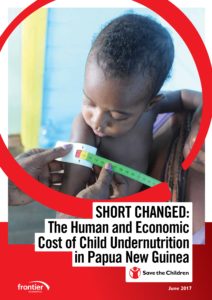New report reveals child undernutrition costs the PNG economy up to $1.5 billion per year
In June 2017, a new report was launched by Save the Children Australia which identifies the human and economic cost of child undernutrition in Papua New Guinea (PNG). The ground-breaking findings highlight that child undernutrition costs the PNG economy up to $USD 1.5 billion in a single year (FY 2015-16), representing 8.45% of its gross domestic product.
 In June 2017, a new report was launched by Save the Children Australia which identifies the human and economic cost of child undernutrition in Papua New Guinea (PNG). The ground-breaking findings highlight that child undernutrition costs the PNG economy up to $USD 1.5 billion in a single year (FY 2015-16), representing 8.45% of its gross domestic product.
In June 2017, a new report was launched by Save the Children Australia which identifies the human and economic cost of child undernutrition in Papua New Guinea (PNG). The ground-breaking findings highlight that child undernutrition costs the PNG economy up to $USD 1.5 billion in a single year (FY 2015-16), representing 8.45% of its gross domestic product.
PNG is facing a nutrition crisis. Alarmingly, almost one in two children in PNG have stunted growth due to chronic malnutrition. PNG has the fourth highest child stunting rate in the world – a rate that is more than double the global average and higher than some of the most impoverished countries in Africa and Asia.
Undernutrition weakens a child’s immunity and causes them to suffer more frequent and severe episodes of disease. According to national data in PNG, approximately 33% of all hospital deaths of children under five are either directly or indirectly caused by malnutrition. However, Frontier Economics estimates that malnutrition could be the underlying cause of up to 76% of total deaths of children under five across community and health facilities combined.
Our report shows that nutrition interventions have comparatively high economic and social returns on investment. It is critical to invest in human development as a foundation for inclusive and sustainable economic development. Otherwise, malnutrition will continue to undermine the great human and economic potential of our nearest neighbour.”
Majella Hurney, Save the Children Australia’s Head of Policy.
Ms Hurney added that food insecurity was not the core driver of such high child malnutrition rates. Rather, low rates of exclusive breastfeeding, and poor water, sanitation and hygiene practices contribute to a high prevalence of diseases such as diarrhoea, which cause and exacerbate child malnutrition. She added that while the Australian Government is the largest bilateral donor to PNG, latest available data indicates that only 0.1% of its overseas development assistance to the nation was allocated to nutrition.
The Government of Papua New Guinea is taking positive steps to improve child nutrition, but it cannot tackle a challenge of this scale alone. There is an urgent need for donors, such as Australia, to reallocate technical and financial assistance to support targeted interventions to improve child nutrition,”
Majella Hurney, Save the Children Australia’s Head of Policy.
Frontier Economics supported the report with economic modelling and analysis. Additional contributions came from the Burnet Institute, Save the Children PNG, Save the Children UK and UNICEF PNG.
- Full report: Short Changed: The Human and Economic Cost of Child Undernutrition in Papua New Guinea
- Media release: http://www.savethechildren.org.au/about-us/media-and-publications/media-releases
- Radio broadcast: http://www.abc.net.au/news/2017-06-21/png-suffering-from-under-nutrition-of-children/8637362
The fabulous Majella Hurney launching our report on #malnutrition in #PNG and the role #AustralianAid can play to save kids lives pic.twitter.com/88twAlsyA3
— Mat Tinkler (@TinklerMat) June 21, 2017